Headlines and events archive
Displaying 251 - 300 of 1543
You may also find an archive of news published in the media which are related with the Instituto de Astrofísica de Andalucía - CSIC.
Pages
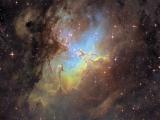
|
29/11/2021 - 03/12/2021
2nd IAA-CSIC Severo Ochoa School on Statistics, Data Mining, and Machine Learning Granada |
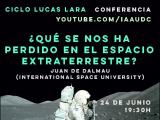
|
24/06/2021 - 19:30
What have we missed in extraterrestrial space? Juan de Dalmau, president of the International Space University and former director of Ariane rocket launch operations in French Guiana, will answer frequently asked questions about space exploration. Juan de Dalmau |
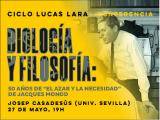
|
27/05/2021 - 19:00
Biology and philosophy. 50 years of Jacques Monod's "Chance and Necessity". In the book "Chance and Necessity", published in 1970, Monod examines the philosophical implications of modern biology. Josep Casadesús |

|
29/04/2021 - 19:00
Azarquiel, the chiseler of ideas The history of science in Spain has never been a subject that has been valued in its fair measure, even by Spanish scientists themselves today. In this talk we will focus on the figure of Azarquiel, representative of medieval science. Antonio Claret |
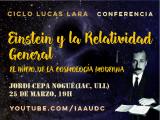
|
25/03/2021 - 19:00
Einstein and General Relativity. The beginning of modern cosmology The General Theory of Relativity has represented, together with quantum physics, the beginning of the so-called modern physics. Jordi Cepa Nogué |
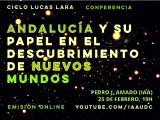
|
25/02/2021 - 19:00
Andalusia and its role in the discovery of new worlds In twenty-five years we have gone from thinking that our Solar System was the only one in the Galaxy to knowing that there are thousands of planets already detected and that there could be billions out there. Pedro J. Amado |
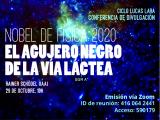
|
29/10/2020 - 19:00
Nobel Prize in Physics 2020: the black hole in the Milky Way galaxy Andrea Ghez and Reinhard Genzel were awarded the Nobel Prize in Physics 2020 for their discovery of the massive black hole at the center of the Milky Way. In my talk I will review the history of their research work from a front-line point of view (having worked closely with the two researchers on this topic). I will explain the methods and measurements they used and the strength of their results. Rainer Schödel |
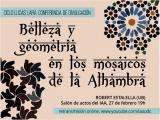
|
27/02/2020 - 19:00
Beauty and geometry in Alhambra mosaics Dissemination conference, Lucas Lara cycle. Robert Estalella |
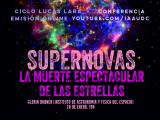
|
28/01/2021 - 19:00
Supernovae: the spectacular death of stars A star that goes out in the universe ending its life as a supernova is a source of everything but darkness. Gloria Dubner |
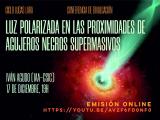
|
17/12/2020 - 19:00
Polarized light in the vicinity of supermassive black holes Relativistic jets produced by supermassive black holes are the most energetic astrophysical objects known and can be observed up to enormous distances and very early ages in the universe. This lecture will focus on these objects, and more specifically on their main characteristics and the extra information provided by studying the polarized light they emit, as well as the main questions that remain to be answered to fully understand them. Iván Agudo |

|
26/11/2020 - 19:00
The Symbolic Primate. How language and culture made us human Humans diverged from our closest relative, the chimpanzee, about seven million years ago, a relatively short time from an evolutionary point of view. Biological continuity with the chimpanzee is evident in many physiological and behavioral aspects; equally evident is the cognitive gap between the two species. In this talk I will attempt to outline the process of hominization based on data from paleontology, genetics, bioinformatics,... Pablo Rodríguez Palenzuela |

|
20/09/2021 - 23/09/2021
SO Instrumentation School: III. Beckhoff Motion Control Granada |

|
16/09/2021 - 12:30
Precision cosmology: now what? The standard cosmological model (the LCDM model) has been established and its parameters are now measured with unprecedented precision. This model successfully describes observations from widely different epochs of the Universe, from primordial nucleosynthesis all the way to the present day. However, there is a big difference between modelling and understanding. The next decade will see the era of large surveys; a large coordinated effort of... Dra. Licia Verde |

|
22/07/2021 - 12:30
Revealing cosmic magnetism with the Square Kilometre Array and its pathfinders Magnetism is an enigmatic but crucial element of our Universe. The structure and strength of magnetic fields are important for a full understanding of astrophysics over a tremendous range of scales: from stellar systems, to star forming regions, the properties and evolution of individual galaxies, galaxy groups and clusters, and even as a major element of the Cosmic Web. The Square Kilometre Array (SKA) promises to deliver a revolutionary view... Dr. George Heald |

|
01/07/2021 - 12:30
SO Colloquium: Interstellar planetesimals: 1I/Oumuamua and 2I/Borisov Extensive surveys of extrasolar planets and of circumstellar disks around nearby stars show that planets and dust-producing planetesimals, similar to the asteroids, Kuiper belt objects and comets in our solar system, are ubiquitous around others stars. The planetesimal population of the young solar system was very numerous initially but the majority of the objects ended up ejected due to gravitational perturbations with the planets and other... Dra. Amaya Moro-Martín |

|
09/06/2021 - 10/06/2021
Scientific writing and presentation in astronomy On Line |

|
09/06/2021 - 09/06/2021
Horizon Europe: Workshop on RESEARCH INFRASTRUCTURE On line |

|
21/06/2021 - 25/06/2021
English for Academic Purposes - an online workshop series for young researchers On line |

|
08/06/2021 - 16:00
K-band interferometric imaging of the M-type Mira star ‘R Car’ The final stage of low to intermediate-mass stars, also known as the asymptotic giant branch (AGB), presents circumstellar envelopes (CSE); however the mechanisms that lead to the formation of these structures, at least in M-type AGBs, are still not well understood. In order to grasp the characteristics of the CSE, it has been found that the CO molecule plays an important role due to its stability against dissociation, making it a tracer of the... M.Sc. Abel Rosales-Guzmán |
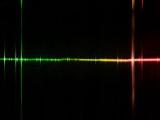
|
14/06/2021 - 14/06/2021
An Introduction to IFU Spectroscopy On line |

|
10/06/2021 - 01/07/2021
Ansys Workbench for Scientific Instrumentation Online |

|
11/05/2021 - 12:30
Is the Bremer Deep Field Ionised at z=7? The talk will show that the population of star forming galaxies in the Bremer Deep Field (BDF) has formed two large ionised bubbles. The sources in the BDF have been completed with a set of expected, though not detected, low luminosity sources at z ~ 7. We have estimated the number of ionising photons produced per second by the different star forming galaxies in the BDF and have compared it with the number that would be required to reionise... Jose Miguel Rodriguez Espinosa |

|
10/06/2021 - 12:30
SO Webloquio: Auroral Radio Emission in stars and exoplanetary systems In recent years, an interesting type of coherent radio emission has been detected in a wide variety of stars across the HR diagram, from hot magnetic A-B MS stars to Ultra Cool dwarfs: the Auroral Radio Emission (ARE), previously observed by spacecrafts in the magnetosphere of planets of the Solar System. Very different objects are showing the same phenomenon. What do they have in common? The first star with ARE was CU Virginis, an early type... Dr. Corrado Trigilio |

|
28/04/2021 - 30/04/2021
SO instrumentation school: High level sinthesys for Xilinx FPGAs using Vivado HLS On line |

|
07/04/2021 - 07/04/2021
Matplotlib for Beginners - A Brief Severo Ochoa Workshop Online |

|
17/06/2021 - 12:30
SO Webloquio: Star-formation and accretion in galaxies from near to far: the LeMMINGs and eMERGE e-MERLIN legacy programmes Radio emission provides a uniquely powerful and unobscured probe of the two key physical processes underway in, and powering, galaxies and their evolution: Accretion on to their central SMBH, and star-formation processes. To explore these processes, and their role in galaxy evolution, we require very high resolution (sub-arcsecond or better), sensitive imaging at radio wavelengths across large samples of galaxies in both the local and distant... Dr. Rob Beswick |

|
27/04/2021 - 12:30
SO Webloquio: Chaos and Instabilities in Planetary Systems The aim of this talk is to discuss recent results on the estimation of instability times through Shannon entropy and its application to planetary systems. We will analyze the complex relation between chaos and orbital instability, and how each is able to provide important information about the dynamical evolution of the system. Finally, we will analyze how different well known planetary systems These concepts will then be applied to several... Dr Cristian Beauge |

|
06/04/2021 - 13:30
SO Webloquio: James Webb Space Telescope Capabilities for Planet and Exoplanet Observations JWST, scheduled for launch in October, will bring a new generation of instruments, infrared detectors, and a passively cooled 6.5 m primary mirror to space-based astronomy. I will discuss its imaging and spectroscopic modes, which cover wavelengths from 0.6 - 28.5 microns, and the observatory's moving-target tracking, and coronagraphic and time-series modes for direct or transit observations of exoplanets. I will show some statistics for the... Dr. John Stansberry |

|
24/06/2021 - 12:30
SO Webloquio: Asteroid sample return: A laboratory perspective The new generation of sample return missions from small bodies is delivering to us fresh witnesses from the early Solar System. In this context, laboratory studies play a double role: on one hand, in-depth laboratory analysis of retrieved samples using state-of-the-art techniques give us an unprecedentedly detailed look at the formation and evolution of organic materials in asteroids; on the other hand, in the laboratory we can perform... Dr. Rosario Brunetto |

|
09/09/2021 - 17:00
SO Webloquio: A new look at our star: the Daniel K. Inouye Solar Telescope The Sun represents a template for much of our understanding of the workings of a "cool" star, and its proximity allows us to observe exquisite details at its surface, with current facilities routinely reaching resolutions of few hundreds of km on the solar disk. Yet, many questions still linger, in particular concerning the actual mechanism(s) that create and maintain a hot outer atmosphere (chromosphere, transition region and corona) as well as... Dr. Gianna Cauzzi |

|
27/05/2021 - 17:00
SO Webloquio: A Spanish in Boulder The opportunity to lead the US National Solar Observatory (managed by AURA) since 2013 has allowed me to understand the differences in how R... Dr. Valentin Martínez Pillet |

|
20/05/2021 - 12:30
SO WebLoquio: Regularly-spaced 8 micron cores as tracers of the earliest stages of star formation in the spiral arms of nearby galaxies Archival Spitzer Space Telescope images of most nearby spiral galaxies show prominent 8 micron emission cores when viewed with an unsharp mask technique. These cores have the IR colors of young star-forming regions, typically a million years old, behind several tens of magnitudes of optical extinction. They are usually invisible in optical images, and yet the sum of their masses divided by their likely age is comparable to the total star... Dr. Bruce Elmegreen |

|
13/05/2021 - 12:30
SO Webloquio: The HIRES/ELT consortium, instrument and science We present the results from the phase A study of ELT-HIRES, an optical-infrared, high-resolution spectrograph for ELT, which has just been completed by a consortium of 30 institutes from 12 countries forming a team of about 200 scientists and engineers. The top science cases of ELT-HIRES will be the detection of life signatures from exoplanet atmospheres, tests on the stability of Nature's fundamental couplings, the direct detection of the... Dr. Alessandro Marconi |

|
06/05/2021 - 12:30
SO Webloquio: Nuclear star clusters I review the current knowledge about nuclear star clusters (NSCs), and the spectacularly dense and massive assemblies of stars found at the centers of most galaxies. Understanding the formation, growth, and ultimate fate of NSCs is crucial for a complete picture of galaxy evolution. There is a clear transition mass in galaxies of ∼ 10^9 Msol where the characteristics of NSCs change. I argue that at lower masses, NSCs are formed primarily from... Dr. Nadine Neumayer |

|
30/03/2021 - 12:30
SO Webloquio: Star-forming Complexes in Local Mergers and High Redshift Galaxies Disk galaxies at high redshift contain star-forming complexes, or clumps, whose masses and sizes far exceed those of clumps in local non-interacting galaxies. However, our recent Hubble Space Telescope observations reveal that local merging galaxies can form massive clumps like those at high z, with the same range of physical size, surface density, age, and star formation rate. These similarities, combined with the loss at high redshift of low... Dr. Debra Elmegreen |

|
19/04/2021 - 23/04/2021
SOMACHINE 2 Machine Learning, Big Data, and Deep Learning in Astronomy On line |

|
29/04/2021 - 12:30
Extreme Blazars Blazars are jetted active Galactic Nuclei with the jet axis oriented close to the line of sight of the observer. Non-thermal emission processes in the jet cover the whole electromagnetic spectrum from radio wavelengths to TeV gamma rays, with a characteristic double-humped Spectral Energy Distribution (SED). Relativistic amplification effects on the observed fluxes make their jets ideal candidates for detection at any wavelength. A physically... Dr. Giacomo Bonnoli |

|
08/04/2021 - 12:30
On the effects of Initial Mass function on the galactic chemical enrichment: the role of Pair Instability Supernovae We built new sets of chemical yields from massive and very massive stars up to Mi ~ 350 Msun, by combining the wind ejecta extracted from our hydrostatic stellar evolution models with explosion ejecta from the literature. Using a simple chemical evolution code we analyse the effects of adopting different yield tables by comparing predictions against observations of stars in the solar vicinity. Our study indicates that PISN played a significant... Dr. Sabyasachi Goswami |

|
22/04/2021 - 12:30
Gas-poor clusters: what kind of beasts are they? The known variety of galaxy clusters is constantly increasing with our progress in understanding the severity of selection effects on observational samples and with obvious implications on cosmology and cluster physics. In the talk, after a general introduction on galaxy clusters and a reminder on selection effects, I present perhaps the first X-ray unbiased sample of clusters with known masses and X-ray follow-up, its more variegate nature... Dr. Stefano Andreon |

|
20/01/2021 - 20/01/2021
El cielo oscuro como recurso científico, cultural, medioambiental y turístico Sevilla, Virtual Format |

|
20/02/2019 - 22/02/2019
Ciencia presente y futura con CARMENES & 1er encuentro EXONET Granada |

|
26/02/2019 - 27/02/2019
PLATO Limb-Darkening Meeting #1 Granada |
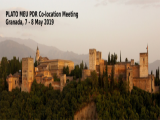
|
07/05/2019 - 08/05/2019
PLATO MEU PDR Co-location Meeting Granada |
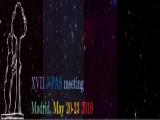
|
20/05/2019 - 23/05/2019
17th J-PAS Collaboration Meeting Madrid |
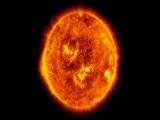
|
18/09/2019 - 19/09/2019
SOLARIS-HEPPA Working Group meeting Granada |

|
30/09/2019 - 04/10/2019
6th Workshop on Robotic Autonomous Observatories Torremolinos |
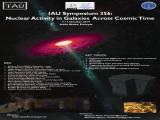
|
07/10/2019 - 10/10/2019
IAU Symposium 356: "Nuclear Activity in Galaxies Across Cosmic Times" Addis Abeba |
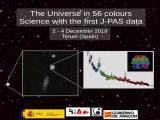
|
02/12/2019 - 04/12/2019
The Universe in 56 colors. Science with the first J-PAS data Teruel |

|
12/03/2020 - 13/03/2020
Public surveys and new instrumentation for Calar Alto Observatory Granada - Virtual Format |

|
11/03/2021 - 12:30
Optical polarization of radio-quiet active galactic nuclei and its repercussion within the changing-look scenario The core of Active Galactic Nuclei (AGN) remains under the resolution limit of the vast majority of current telescopes. However, polarimetry provide us with information of those unresolved regions, which would be inaccessible in natural light, such as the presence of dust, magnetic fields or scattering regions. This talk will be focused on the optical polarization properties of radio-quiet AGN and its relation with the geometry of the scattering... Dr. Beatriz Agis González |